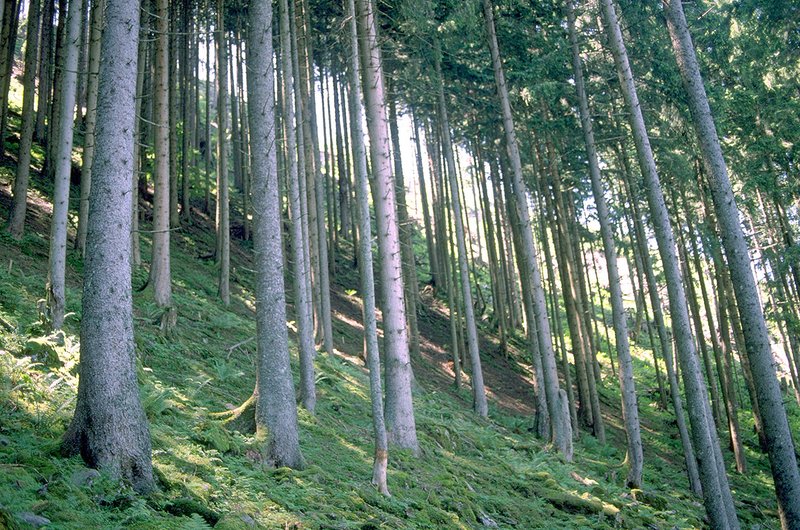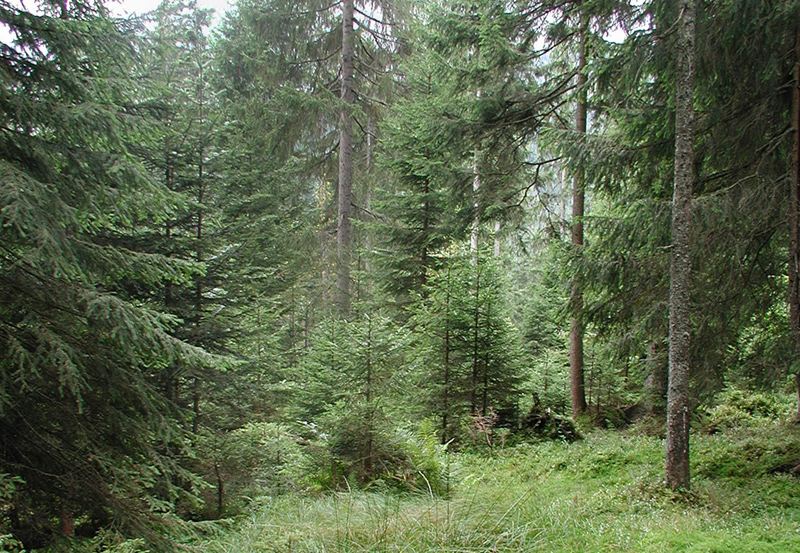Most of the barrier woodlands in the Alps are made up of spruce-fir tree forests, sub-alpine spruce forests and in the inner alpine areas of forests consisting of larch and Swiss stone pines. According to present day knowledge barrier woodlands filling the following criteria offer the best resistance to storms and snow loads:
- irregularity vertically and horizontally
- all-aged
- in so called group structure i.e. structured with trees arranged in groups
- well spread out and with viable regeneration
This type of forest should be able to permanently offer the sort protection which is demanded of it. According to the latest research well structured stands with a wide range of diameters provide the best long term protection against rock fall.
Many uniform stands exist today
In the Swiss mountains there are many spruce stands, which due to economic reasons, have not been managed for many years. At present uniform stands of spruce trees can be found on slopes which were previously free of trees due to clearance, deforestation, forest fires or storm damage. In other places an intensive, and then abandoned, practice of grazing has led to overgrown homogenous stands. If these stands were left to themselves without being thinned out, their structure in certain locations would deteriorate (higher h/d ratio and shorter crowns, etc.) and the resistance to storms and snow load would decrease.
Aim: Mountain Selection Forests
Silvicultural techniques therefore aim at gradually transforming such stands into non-uniform mountain selection forests over a middle (20 to 50 years) to long (50 to 150 years) time span, depending on their initial condition, using various intervention techniques. The concept of this procedure is clear, but it has not often been put into practice. The question then arises is it actually possible to achieve the objectives of “mountain selection forests” when transforming tightly standing spruce stands with regularly distributed short crown trees
Long term observation areas
A project of the Federal Research Institute (WSL) is documenting and investigating how calculated intervention in “problem stands” works out in the long term in set locations. Together with local forestry services researchers have, between 1993-1998, set up four new long term observation areas of uniform tightly packed spruce stands in the Swiss and Lichtenstein Alps. These areas are in Plasselb (FR), Triesenberg (FL), Elm (GL) and Siat (GR) and are between 1360 m and 1620 m above sea level. Each of these areas contains a neighbouring control area in which no intervention takes place. The long term observations should supply answers to the following questions:
- How do various stand structure parameters change due to thinning out?
- Are the treated areas developing in the right direction? Is there rejuvenation and are they really developing better than neighbouring stands where no intervention is taking place?
- Are the stands successfully being transformed, step by step, into more stable mosaic like mountain selection forests?
Preliminary results
The first results showed that out of the investigated parameters the spatial spread of trees (aggregations index RC&E), the density of the stand (Stand Density Index) SDI and the grade of slenderness reacted most sensitively to the intervention. They seem to be good indicators of the success of the chosen intervention. This is because these parameters are directly influenced by change in the numbers of stems and the spatial spread of removed trees. The length of crown and the so called homogeneities coefficient react less strongly and are therefore less suitable to show short term effects of intervention.
On the basis of the first results it can be concluded that it is possible, starting with varying conditions, to steer stand structures in the direction of a non-uniform uneven-aged mountain selection forest. The long term effect of these changes, however, can only be judged after further monitoring.
Translation: Dawn Meister, Stallikon


